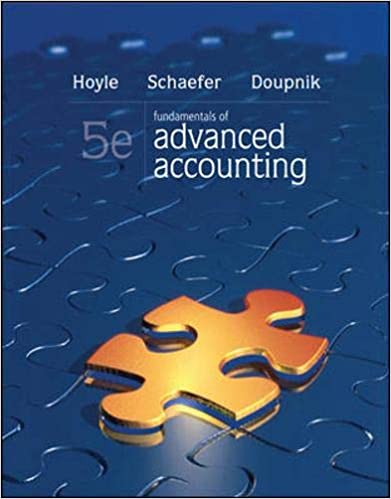
Fundamentals of Advanced Accounting 5th Edition by Joe Ben Hoyle,Thomas Schaefer,Timothy Doupnik
Edition 5ISBN: 978-1260575910
Fundamentals of Advanced Accounting 5th Edition by Joe Ben Hoyle,Thomas Schaefer,Timothy Doupnik
Edition 5ISBN: 978-1260575910 Exercise 53
Smith purchased 5 percent of Barker's outstanding stock on October 1, 2011, for $7,475 and acquired an additional 10 percent of Barker for $14,900 on July 1, 2012. Both of these purchases were accounted for as available-for-sale investments. Smith purchases a final 20 percent on December 31, 2013, for $34,200. With this final acquisition, Smith achieves the ability to significantly influence Barker's decision-making process and employs the equity method.
Barker has a book value of $100,000 as of January 1, 2011. Information follows concerning the operations of this company for the 2011-2013 period. Assume that all income was earned uniformly in each year. Assume also that one-fourth of the total annual dividends are paid at the end of each calendar quarter.

On Barker's financial records, the book values of all assets and liabilities are the same as their fair values. Any excess cost from either purchase relates to identifiable intangible assets. For each purchase, the excess cost is amortized over 15 years. Amortization for a portion of a year should be based on months.
a. On comparative income statements issued in 2014 for the years of 2011, 2012, and 2013, what would Smith report as its income derived from this investment in Barker
b. On a balance sheet as of December 31, 2013, what should Smith report as its investment in Barker
Barker has a book value of $100,000 as of January 1, 2011. Information follows concerning the operations of this company for the 2011-2013 period. Assume that all income was earned uniformly in each year. Assume also that one-fourth of the total annual dividends are paid at the end of each calendar quarter.

On Barker's financial records, the book values of all assets and liabilities are the same as their fair values. Any excess cost from either purchase relates to identifiable intangible assets. For each purchase, the excess cost is amortized over 15 years. Amortization for a portion of a year should be based on months.
a. On comparative income statements issued in 2014 for the years of 2011, 2012, and 2013, what would Smith report as its income derived from this investment in Barker
b. On a balance sheet as of December 31, 2013, what should Smith report as its investment in Barker
Explanation
Equity Method of Accounting is adopted b...
Fundamentals of Advanced Accounting 5th Edition by Joe Ben Hoyle,Thomas Schaefer,Timothy Doupnik
Why don’t you like this exercise?
Other Minimum 8 character and maximum 255 character
Character 255


